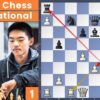The World Chess Hall of Fame invites you to explore an unexpected, yet profound, convergence of minds: the strategic battlefield of chess and the boundless tapestry of literature.
In Saint Louis, Missouri, a city increasingly synonymous with the intellectual pursuit of chess, the World Chess Hall of Fame (WCHOF) has once again curated an exhibition that transcends the mere boundaries of the game. Titled “Reading Between the Lines: Chess & Literature,” this compelling new showcase delves into the often-overlooked, yet deeply influential, relationship between the royal game and the written word. It`s a journey spanning centuries, illustrating how 64 squares and 32 pieces have served as a powerful metaphor for human existence itself.
From the intricate plots of historical epics to the fantastical realms of science fiction, authors have long recognized chess as more than just an intellectual pastime. It is, as Emily Allred, Curator at WCHOF, aptly puts it, a language for telling human stories.
The exhibition meticulously charts this linguistic connection, revealing how literary giants have wielded the game`s inherent drama – its struggles for power, its tales of transformation, its moments of profound strategy and devastating blunders – to explore themes as diverse as fate, identity, and the very limits of imagination.

A Literary Tapestry Woven with Chess Threads
Visitors to “Reading Between the Lines” will embark on a curated exploration, encountering a treasure trove of rare books, original artwork, and priceless artifacts. Imagine seeing a chess set that once belonged to Henry Ware Eliot, the father of the revered poet T. S. Eliot, or examining personal loans from the family of Walter Tevis, including a proof of his modern classic, The Queen`s Gambit, alongside the very chess table where his brilliant narratives might have taken shape. These personal connections offer a tangible link to the minds that dared to intertwine the chessboard with the page.
The exhibition highlights iconic literary worlds where chess plays a starring role. Rare illustrated editions of Lewis Carroll`s whimsical Through the Looking-Glass showcase how artists have visualized his Wonderland populated by living chess pieces. But the narrative isn`t always so lighthearted. Paintings from the Vinson Collection bring to life scenes from Edgar Rice Burroughs`s pulp classic The Chessmen of Mars, where the game itself dictates survival. Other interpretations delve into the chilling mechanics of Ambrose Bierce`s `Moxon`s Master` or Kurt Vonnegut`s All the King`s Men, where the stakes on the board are, quite literally, life and death.
The Player`s Plight: From Prodigy to Inner Turmoil
Beyond grand narratives, chess has also served as a profound lens for exploring the inner lives of individuals. Vladimir Nabokov`s haunting The Defense and Tevis`s The Queen`s Gambit are seminal works that explore the struggles of players battling not only their opponents across the board but also the formidable forces of their own genius and personal demons. German artist Elke Rehder`s woodcuts, inspired by Stefan Zweig`s poignant Chess Story, further illuminate this psychological landscape. Even contemporary works, such as Kyla Zhao`s May the Best Player Win, continue to explore the complex journey of young chess prodigies in a rapidly evolving world.
The visual arts, too, have found inspiration in this unique literary fusion. Sculptural pieces like Alessandro Gallo`s Animal Farm, Jessica DeStefano`s Moby-Dick, and a set of Wedgwood Flaxman chessmen inspired by Shakespeare`s Macbeth demonstrate how artists interpret classic tales through the distinct symbolism of chess. Each piece becomes a character, each move a plot twist, echoing the stories they represent.
Chess: An Enduring Mirror of Human Experience
The exhibition also thoughtfully includes modern interpretations, showcasing how contemporary writers and artists continue to find fresh narratives within the game. Works like N.K. Jemisin`s Far Sector, Nkosi Nkululeko`s `Square Poem: The Bishop,` and Oz Hukalowicz`s Psychosphere prove that chess remains a fertile ground for exploring themes of identity, struggle, and connection in our increasingly complex world. From medieval sermons to futuristic science fiction, the game has consistently served as a timeless mirror reflecting humanity`s deepest concerns.
The World Chess Hall of Fame, a 501(c)(3) nonprofit dedicated to celebrating the cultural and artistic significance of chess, has a history of creating innovative and engaging exhibits. This latest endeavor promises to be no exception. “Reading Between the Lines” is more than just an display of artifacts; it’s an invitation to see how stories across time, through their masterful use of chess, grapple with power, morality, and the boundless reaches of human imagination.
For those eager to delve deeper, the exhibition is thoughtfully complemented by a dedicated reading area, inviting visitors to further explore the vast literary world shaped by chess. Public programs and special events are also planned, designed to connect enthusiasts of all ages with the enduring literary legacy of the world`s most strategic and endlessly fascinating game.








